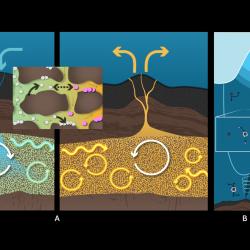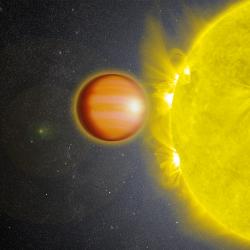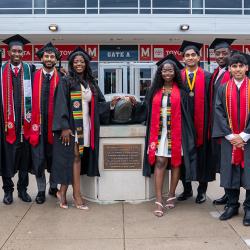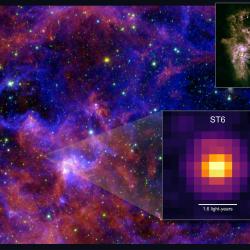Measurements that Matter
Systems engineer Sven Geier (Ph.D. ’00, astronomy) builds space instruments that push the boundaries of measurement, spectroscopy and scientific discovery.
Sven Geier (Ph.D. ’00, astronomy) builds complex analytical instruments that help unravel the mysteries of Earth and space.
“Where others ask, ‘Can you even measure that?’, we build the devices that do it from space,” Geier explained.
 As an instrument systems engineer at NASA’s Jet Propulsion Lab (JPL) in Pasadena, California, Geier has been building, designing, and tuning space tools that measure atmospheric and environmental conditions, geology, plant biology, and other phenomena on Earth and beyond since 2005. In many cases, this involves spectroscopy, a technique that uses particles of light called photons to study the interaction of light and matter, a process that can reveal a wealth of information about the composition and density of earthly—and not-so-earthly—objects and materials. And the possibilities just keep growing.
As an instrument systems engineer at NASA’s Jet Propulsion Lab (JPL) in Pasadena, California, Geier has been building, designing, and tuning space tools that measure atmospheric and environmental conditions, geology, plant biology, and other phenomena on Earth and beyond since 2005. In many cases, this involves spectroscopy, a technique that uses particles of light called photons to study the interaction of light and matter, a process that can reveal a wealth of information about the composition and density of earthly—and not-so-earthly—objects and materials. And the possibilities just keep growing.
“I'm just totally enamored with the way we can pour ever-cleverer new technology into making even better ways to look at reality itself,” Geier explained. “There's always a new cutting edge to push imaging spectroscopy to ever more fidelity, more precision, to squeeze ever more information out of fewer photons,” Geier explained. “We're on the edge of that—what are people measuring and what are the limitations? And we always have to foresee that next question—what will people want to measure next?”
Over the last 20 years, as JPL’s technical group lead for imaging spectroscopy, Geier has worked on dozens of complex devices, from an instrument that mapped the rocky terrain of the moon to an infrared imaging spectrometer that can identify, measure and monitor features of the Earth's surface and atmosphere, pixel by pixel. For Geier, every project means something new to discover.
“I find this so wonderful, how we're pushing the technology and the technology is pushing us to be at the forefront,” he said. “What I really like about hardware is if something doesn't work, I know I'm about to learn something.”
Reaching for the stars
From his early years growing up ‘in the middle of nowhere’ in Germany, Geier was intrigued by the stars and the sky.
“The memory I have is that when I was really young, my mother got me this kids’ book about astronomy because I was already interested. I was asking a lot of questions about planets and stars,” Geier recalled. “In hindsight, the book was probably a little bit beyond my level, but my mother was never afraid of giving me something that was past my reach and encouraged me to reach for it.”
In high school, Geier connected with the complex calculations of math and physics.
“Anybody can talk about stuff happening, but with math and science, you can actually calculate it,” he said. “You let go of something and it falls down, but when you can actually compute how long it takes to hit the ground and how hard it hits the ground, that’s cool—there’s always more going on than meets the eye.”
Geier earned his undergraduate degree in physics at Hamburg University, becoming more fluent in English along the way, thanks to a semester he spent in Hungary and American TV.
“I didn't speak a word of the language there,” Geier recalled, “but in Hungary everybody speaks English—and I watched a lot of MTV.”
Measurements and spectrometers
When the time came for graduate school, Geier’s longtime interest in physics and astronomy steered him toward the University of Maryland, where he met astronomers who were doing research at NASA’s Goddard Space Flight Center. He eventually landed a summer job with a group tackling the challenges of measurements and spectrometry.
“They were looking at these space radiation interaction-type things,” he explained. “They were trying to find out what happens to the stuff that rains down on the top of the atmosphere, what is interesting about the things that are coming down and how can we create a device—a spectrometer—to measure this. And that became my Ph.D. thesis.”
In 1998, Geier’s team launched a balloon carrying their device—a magnetic rigidity spectrometer—into the atmosphere. From the hardware build to the test flight, data collection and analysis that followed, Geier realized this was the kind of work he wanted to do; this was scientific discovery he could get excited about.
“I realized that this is where I want to go in deep depth. How would we go about measuring the energy of a particle that's coming out from who-knows-where in the galaxy and hitting something?” Geier explained. “And then you come up with some hare-brained idea, and you put together a prototype that looks like it might work. I found this just to be such a fascinating process that I can enthusiastically wave my arms about all day long.”
After earning his Ph.D. in 2000, Geier went on to do postdoctoral research at the California Institute of Technology before transitioning to JPL in 2005.
“I asked around, and the guy who was the section manager for the instrument section thought that I would be a good fit in the spectroscopy group,” Geier recalled. “By then, I'd been building spectrometers for a few years, so I said ‘Sure, why not?’ And I've been there ever since.”
Over the next two decades, Geier and the JPL instrument team built a variety of unique measuring devices. One of them, the Moon Mineralogy Mapper known as M3, flew on India’s first mission to the moon, capturing worldwide attention in 2009 when it delivered the first high-resolution map of the lunar surface.
“M3 was the first instrument that I thought was really cool. We wanted to find out what the rocks on the moon are made of, and you can do that with a spectrometer, so we built that instrument and it flew to the moon and made the first mineral moon map,” Geier explained. “The map made the cover of Science, and it confirmed the presence of water molecules in the moon’s polar regions. That was our instrument, and to this day it’s the most cited paper with my name on it.”
‘At the cutting edge of what’s possible’
Geier also developed instruments for the Orbiting Carbon Observatory, which was designed for space-based observations of atmospheric carbon dioxide, and worked on a remote surface-mapping system called AVIRIS: the Airborne Visible Infrared Imaging Spectrometer.
“You fly over an area and it’ll give you a map, and in every pixel on the map, I can tell you the exact chemistry that's happening in that pixel, whether you want to look at agriculture, forestry, land use or water management,” he explained. “We’ve had an instrument flying in Peru that can make a map of the forest and color-code every tree by what species it is. You can overfly a vineyard, and I can tell you where the invasive species are. So, yeah, this has really gotten interesting just the last couple of years and I think it’s only going to grow.”
Whether it’s trees in Peru, rocks on the moon or invisible gases in the atmosphere, the science of measuring things from space just keeps getting better, according to Geier.
“We're measuring things that just 10 years ago, people would have said you can't do that,” he noted. “I just love seeing people making new breakthrough discoveries based on data gathered with something that didn't exist five years before.”
And he can’t wait to see what’s next.
“In my lifetime, we've gone from parts per million is a challenging measurement to parts per billion is totally doable,” Geier said. “Who knows where we'll be another decade or a couple decades down the road. I'm right here at the cutting edge of what's possible, and there's much more cool stuff to be done.”







